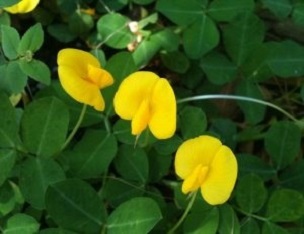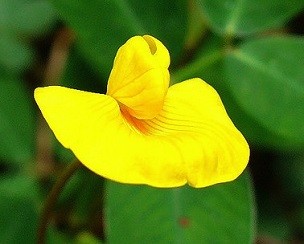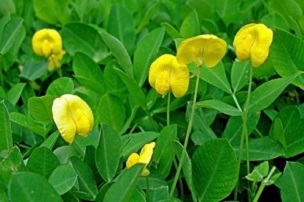From Eat the Weeds
and other things, too
by Green Deane
Perennial Peanut
Arachis glabrata
Perennial
Peanut. The blossoms are edible
We eat the yellow blossoms raw which have a pea to bean-like flavor. 1
An often overlooked and edible ground cover that is blossoming in
warmer areas of the state is Perennial Peanut, Arachis glabrata. In
fact it can replace lawns completely, requires little care, and has an
edible blossom. That’s a triple win. The little plant is long-lived,
tough to kill and tenacious once established. It’s often used in parks
for lawn replacement in spots that are difficult to mow such as around
a rock layout, rough banks, easements, around trees or even strips in a
dirt driveway. An added benefit is that in full sun it grows thick
enough to discourage grass and other weeds. One commercial variety is
called Ecoturf. There is also UF Peace, UF Tito and Florigraze.
Perennial Peanut can be used as livestock feed as a foragable legume
and nitrogen fixer producing three to six tons per acre. 1
I learned of
this edible blossom from a chef who told me she ate them. That got my
attention. Arachis
glabrata, which botanists call by the spiffy name
of Rhizoma Peanut, is also called Rhizomal Perennial Peanut,
Perennial Forage Peanut, Golden Glory, and Ornamental Peanut Grass…
none of them really catchy. It’s related closely to the peanut we eat, Arachis hypogaea
(which by the way has edible stems and leaves, raw or cooked.) 2
My first reference of choice, Cornucopia II, had nothing on the
“Perennial Peanut” nor did my trusty standby, the Journal of Economic
Botany. On-line, where I am loathe to do research unless absolutely
necessary, I turned up little. It is grazing fodder native to Brazil.
No mentions in English of humans eating it. But I did find a study in
which researchers fed leaf powder to hens to see if it increased the
intensity of yoke color. That can go both ways. It would seem
reasonable they would not feed something toxic to hens for a product
humans eat but they do exactly that with arsenic. That chemical is a
disease preventative in chickens. So feeding hens Perennial Peanut leaf
powder was no sign it was edible by humans. 2
It has the characteristic pea blossom of “wings and keel.”
Unlike its edible relating the Perennial Peanut does not bury its head
in the sand.
Finding no good
sources I did what I have done many times in the
compilation of this site: I wrote to one of the foraging study
researchers, Benjamin Anderson, asking if he knew if humans could eat
the plant. He wrote back.
“Yes,
I know that a lot of people eat the blossoms and they actually taste
like peanuts. I have even heard of them being used in
salads. Just be careful eating anything where there may have
been
chemicals sprayed, though.”
I would add yellow
blossoms eaten in quantities also tend to be a laxative. 2
Green Deane's
Disclaimer
Information
contained on this website is strictly and categorically intended as a
reference to be used in conjunction with experts in your area. Foraging
should never begin without the guidance and approval of a local plant
specialist. The providers of this website accept no liability for the
use or misuse of information contained in this website.
Back to
Peanut Page
|
|
Bibliography
1 Deane, Green. "Perennial Peanut Arachis
glabrata." Eat
the Weeds
and other
things, too, Newsletter 29 Jan. 2019,
www.eattheweeds.com/newsletter-29-january-2019/.
Accessed 5 Aug. 2019.
2 Deane, Green. "Perennial Peanut Arachis
glabrata." Eat
the Weeds
and other
things, too, Newsletter 15 Oct.
2013,
www.eattheweeds.com/newsletter-16-october-2018/.
Accessed 7 July 2019.
Published 5 Aug. 2019 KJ
|


